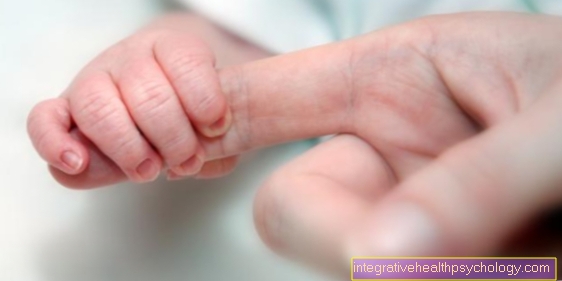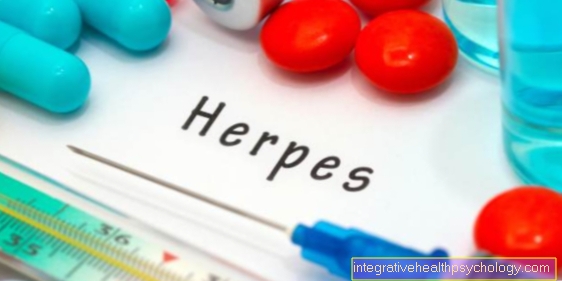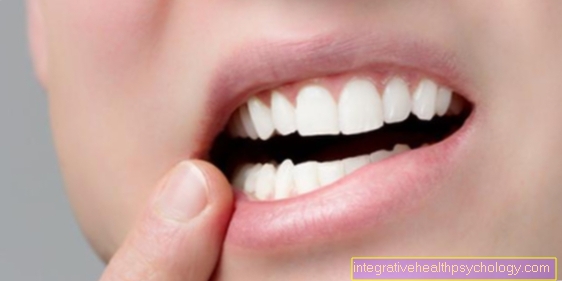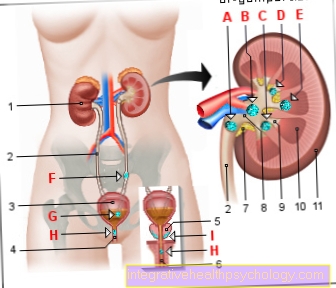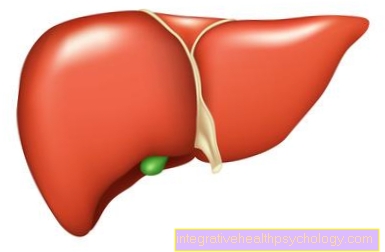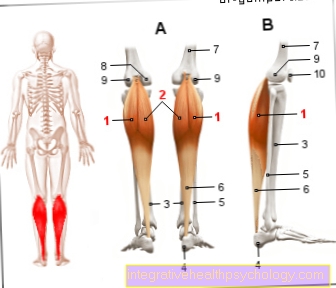Blood poisoning after an insect bite
definition
In technical terms, blood poisoning is called sepsis. Sepsis can occur after an insect bite and is diagnosed on the basis of various parameters, such as symptoms, blood values or pathogen detection. The so-called lymphangitis is also common in everyday language known as blood poisoning. This is an inflammation of the lymph vessels, which can occur, among other things, after an insect bite. As a result of lymphangitis, blood poisoning, i.e. sepsis, can develop, which is a life-threatening situation.
In the event of blood poisoning after an insect bite, immediate action is required as this can lead to organ failure and thus death.
Also read the article on the topic: Lymphangitis after an insect bite

The reasons
Blood poisoning (sepsis) occurs when pathogens or their toxins (poisons) enter the organism. Due to various mechanisms, for example a disturbed immune defense or a very aggressive pathogen, the pathogens or toxins can be washed out into the entire bloodstream. This creates a massive defense reaction throughout the body, which is accompanied by inflammatory processes, oxygen deficiency in organs and circulatory disorders. Organ damage and ultimately death threaten.
Insect bites can cause blood poisoning due to a number of factors. By transmitting pathogens such as fungi and bacteria, insect bites can in very rare cases also lead to blood poisoning. However, a distinction must be made between this and the allergic reaction that can also occur after an insect bite. General symptoms such as high fever, strong inflammatory reactions at the injection site or a pronounced feeling of illness should lead to a doctor's visit.
Find out all about the topic here: Inflamed insect bite - when is it dangerous?
What are the signs?
Insect bites are very rarely the cause of blood poisoning. However, there are signs that could suggest blood poisoning. Very high fever, sudden vomiting, diarrhea or a general feeling of illness are very atypical reactions to insect bites in our latitudes and should therefore be checked by a doctor.
Chills, circulatory problems or impaired consciousness are also signs of blood poisoning after an insect bite. Pronounced inflammatory reactions at the puncture site can also lead to suspicion of blood poisoning.
However, any swelling or redness from the puncture may be a normal reaction to the bite and shouldn't necessarily be a cause for concern.
Read more on this topic at: Inflammation after a mosquito bite.
The diagnosis
Diagnosing blood poisoning involves several important diagnostic tools.
The first important measure is microbiological diagnostics, which are intended to determine the pathogen. For this purpose, among other things, smears are made from the puncture site and blood cultures are taken. In addition, further laboratory diagnostics are arranged. Important parameters are the white blood cells (Leukocytes), which can be increased or decreased in the case of blood poisoning. The inflammation values procalcitionin and CRP are usually increased in blood poisoning and are also determined. The lactate value is also increased.
In addition to these diagnostic measures, it is also very important to examine the patient and ask about his symptoms. Typical are high fever, diarrhea, vomiting, impaired consciousness, circulatory problems and cold sweats. The puncture site may be swollen and red. However, the assessment of the puncture site is of secondary importance, as it can be swollen and reddened even without blood poisoning.
The accompanying symptoms
Blood poisoning after an insect bite can be accompanied by a variety of symptoms. The focus is on symptoms such as high fever, nausea, vomiting and circulatory problems. Disturbances in consciousness are also very typical of blood poisoning.
In addition, depending on the pathogen, different regions of the body can be affected, resulting in specific symptoms. These are, for example, diarrhea, problems with urinating up to failure of kidney function, flank pain or severe headaches. There may be increased swelling and redness at the injection site.
The symptoms of blood poisoning? Find out more about this here.
The swelling
Swelling at the puncture site is not necessarily a sign of blood poisoning after an insect bite. As part of the normal defense reactions of the body, local swellings after insect bites are very common. They can be more pronounced with an allergic reaction or, for example, with constant scratching of the puncture site.
Local inflammation of the lymph vessels, known as lymphangitis, can also be accompanied by swelling of the puncture site. It usually helps to cool the puncture site. However, swelling can also occur with blood poisoning. However, typical accompanying symptoms are decisive for suspicion of blood poisoning, so that the mere presence of a swelling is initially no cause for concern.
Also read the article: How dangerous is lymphangitis
The allergic reaction
Insect bites can cause allergic reactions in some people. Not only bee and wasp bites, but also other insect bites, such as mosquito bites, can cause allergic reactions. It can sometimes be difficult to tell the difference between blood infection and an allergic reaction. However, the allergic reaction is much more common than blood poisoning after an insect bite.
Possible signs are very severe swelling at the injection site, fever, general malaise and circulatory problems. Difficulty breathing is very typical of an allergic reaction. Furthermore, palpitations and tightness in the chest can be strong indicators of an allergic reaction. Rapid and sudden onset of symptoms is also typical.
You can find more information on this topic at: Anaphylactic shock.
What does the red line mean?
Red lines that spread from the insect bite towards the center of the body (for example from the hand or forearm towards the upper arm and shoulder) can indicate blood poisoning after an insect bite. Typically, the lines move from the site of the insect bite with the blood flow and lymph drainage back towards the heart. This suggests that the pathogens also spread from there. They often lead to an inflammation of the lymph vessels, a so-called lymphangitis. These vessels are located superficially, which is why the spread of the pathogen is visible as a red line.
Also read our article: The duration of lymphangitis.
The spread is mostly hematogenous, i.e. via the blood, so that the germs can be sown quickly throughout the body. One speaks therefore of blood poisoning. Once the pathogen has spread throughout the body, serious complications of blood poisoning with organ failure can occur.
The treatment
In the case of blood poisoning, every minute counts, so intensive medical treatment must be initiated immediately.
The focus is on therapy with high-dose antibiotics. Frequently used drugs are piperacillin, tazobactam or ceftazidime. In addition to antibiotic therapy, it is important to monitor and stabilize the circulation. Infusions are given for this purpose. The use of catecholamines such as norepinephrine may also be necessary.
If the puncture is severely infected locally or even an abscess or the like can be seen there, this entry point of the pathogen must be "cleaned up". This can be done through surgical or non-surgical cleansing of the wound and local antibiotics. Those affected also receive thrombosis prophylaxis with heparin. If organ damage has already occurred, special measures must be taken to replace or restore organ function.
Find out more about the here Blood poisoning therapy.
When do i need an antibiotic?
An insect bite usually leads to a local reaction with redness, swelling and pain at the puncture site. The symptoms usually go away after a few days without complications.
However, if bacterial pathogens are transmitted as part of the bite, the infection can spread. A subsequent bacterial infection with skin germs (for example through frequent scratching on an insect bite) can also lead to an infection. If it spreads from the site of the insect bite, the infection should be treated. This is usually done through the systemic administration of an antibiotic in the form of tablets. In severe cases, intravenous antibiotic therapy is also necessary.
In the case of a viral infection after an insect bite, on the other hand, antibiotics do not help, so that such therapy is not necessary.
The duration
Blood poisoning is a very acute disease that must be treated immediately. Do not wait, otherwise serious complications can occur. The condition of those affected worsens within hours and days.
With adequate treatment with antibiotics and other supportive measures, the symptoms can improve again within days. However, some patients may need to be treated for several weeks. This is particularly the case when organs have already been damaged or the blood poisoning is very difficult to treat.
Blood poisoning in pregnancy
During pregnancy, the fear of falling ill is particularly great for many women, as not only their own well-being but also that of the child can be endangered. However, there is usually no need to fear blood poisoning from an insect bite. This complication of an insect bite is extremely rare.
In addition to the usual signs of blood poisoning (see above), other symptoms during pregnancy can lead to suspicion of blood poisoning. Sudden abdominal pain, premature labor, or abnormalities in the CTG are possible signs of blood poisoning. If an insect bite precedes these symptoms, report this to a doctor immediately.
Vaginal bleeding can also occur. Just like outside of pregnancy, immediate therapy is very important to protect the well-being of both the mother and the child.
Here you will find more information: The CTG.





